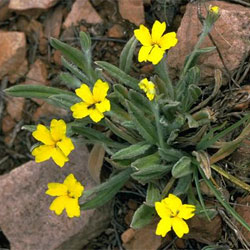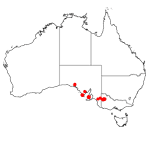Goodenia robusta
 |
Woolly Goodenia
Goodenia robusta (Benth.) K.Krause
Goodenia robusta, commonly known as Woolly Goodenia, is an attractive woolly silvery leaved plant with yellow flowers arranged in racemes.
Goodenia robusta is part of the Goodeniaceae family. The Goodeniaceae family is large (11 genera and c.400 species) and consists of attractive flowering sub shrubs, herbs and some scramblers. The cup at the top of the style (indusium) into which pollen is deposited before the flower opens, distinguishes the plants in the family. The pollen inside the cup is then presented to insect pollinators.
 The
natural habitat of Goodenia robusta is in the semi-arid zone of Australia.
The range of Goodenia robusta extends from the southern regions of South
Australia (including in the Flinders Ranges) into the northwestern mallee region
of Victoria.
The
natural habitat of Goodenia robusta is in the semi-arid zone of Australia.
The range of Goodenia robusta extends from the southern regions of South
Australia (including in the Flinders Ranges) into the northwestern mallee region
of Victoria.
Goodenia robusta is an erect to ascending perennial herb to 40 cm tall. Leaves are crowded basally and have an elliptic to narrowly oblong shape. The leaves are stem clasping, a feature that distinguishes this species immediately from others. The leaves are hairy on both surfaces as the hairs are multicellular (long) and stellate (star shape) giving the leaves that attractive silvery woolly look.
Corolla lobes are five and yellow with fine purple striations. The petals have a thick central zone with slightly gathered thin wings surrounding the edges. The flower is showy and attractive and the corolla can be up to 2 cm wide. The flowering period for Goodenia robusta is from August to December.
Successful horticulture of the plant is possible by meeting its fundamental needs. It can be grown in most parts of Australia provided it has full sun and provided that the winters in the region are not too wet. Goodenia robusta needs a very well drained sandy or loamy soil.
As one may presume from its natural habitat, Goodenia robusta requires very little water. For the first year after planting it may require about ten minutes watering a week and very little after that, making this plant ideal for the perennially dry Australian garden. When watering, it is of particular importance that the leaves are not wetted, so the best method for watering is by a drip irrigation system close to the base. Damp conditions cause the plant to develop fungal diseases.
Propagation of the plant can be achieved by seed and by stolons or suckering shoots that produce plantlets. The plantlets can be harvested and divided up successfully in horticulture during the autumn season after the plant has undergone a long dry spell and is still in the dormant phase. Make sure the plantlets have some roots already and that the soil mixture used is well drained and not too rich.
If growing from seed, the seed needs to be fresh and sown as soon as possible after harvesting. Seed must be allowed to mature inside its own capsule, as green seeds will not germinate. The seed must be allowed to fall from the capsule and may be captured by surrounding the seed head with a fine netting such as a stocking. Once the seed is collected allow it to soak in warm water for 24 to 36 hours to aid germination. This reflects the plants native ecology where seed germination is successful following warm summer rains. Even so germination success in the nursery will be moderate. Generally Goodenia robusta plantlets harvested while the plant is dormant have a much higher success rate of propagation than from seeds.
Goodenia robusta is an excellent addition to rockeries together with Aizoaceae and Chenopodiaceae plant varieties. Its simple requirements make it an ideal garden plant as the community attempts to reduce the vast amounts of freshwater resources consumed by Australian gardens.
Text by Angelina McRae (Botanical Intern 2003)
Derivation of botanical name: Goodenia robustaGoodenia - The genus Goodenia was first described by J.E. Smith in 1794 who named it after Rev.Samuel Goodenough, 1743-1827, Bishop of Carlisle and 1st treasurer of the Linnaean Society. Goodenough, himself a botanist, wrote of seaweeds and sedges. robusta - Latin for 'strong', 'robust', 'resistant'. |
References
AVH - http://www.anbg.gov.au/avh/
Baines, J.A., (1981). Australian Plant Genera. The Society for Growing Australian Plants.
Carolin, R.C., Rajput, M.T.M. & D. Morrison. (1992). Flora of Australia Volume 35, Brunoniaceae, Goodeniaceae, Australian Government Publishing Service, Canberra.
McCann, I.R. (1989). The Mallee in flower. The Victorian National Parks Association, Melbourne.
Personal comm.: Joe McAuliffe.ANBG horticulturalist.
![An Australian Government Initiative [logo]](/images/austgovt_brown_90px.gif)

